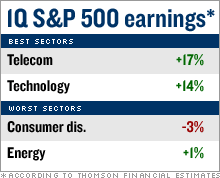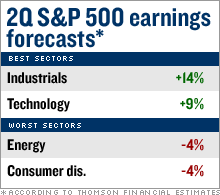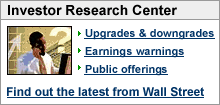Earnings: Surprise, surpriseDespite much hand-wringing, 1st-quarter results have been decent, thanks to tech, telecoms and health care. Here's why.NEW YORK (CNNMoney.com) -- Remember how, a few months ago, CNNMoney (and our competitors, thank you) - not to mention just about all of Wall Street - thought that first-quarter earnings were going to be scary? Yeah, well, sorry about that. Turns out the earnings weren't so bad after all. Although, to be fair, they weren't great either, as GM (Charts, Fortune 500), for one, clearly demonstrated Thursday. Overall, earnings for the quarter are still set to grow at the slowest pace in three and a half years. But that growth is not going to be quite as slow as had been predicted even a month ago.   
With results in from just a bit more than three-quarters of the S&P 500, profits are on track to grow about 7.7 percent from a year ago, according to the latest estimates from Thomson Financial. Before GM dropped its profit bombshell Thursday, the growth rate was closer to 8 percent. When all is said and done, that number will probably end up closer to 9 percent, better than the historic average. But it also means the quarter will break the streak of 14 quarters of growth of at least 10 percent. But 9 percent or so is still a far cry from the 3.3 percent growth expected just a month ago. So what gives? John Butters, senior research analyst at Thomson Financial, cited two main developments. "Analysts cut their estimates during the quarter at a much more rapid pace than previously, and companies didn't raise the bar" as much as they normally do during the "preannouncement period" before results start rolling in, he said. Those made the reported earnings seem especially strong. Butters said that typically analysts lower their forecasts by about 3 percentage points during a quarter - going from betting on 10 percent growth on the first day to 7 percent on the last, for example - as they track warnings or other preannouncements from companies and any setbacks for industries or the economy. Not so in the first quarter, when the drop was more than five percentage points. On Jan. 1, analysts expected 8.7 percent growth, and by the end of March, they expected 3.7 percent growth from the first quarter of 2006. On April 1, the forecasts were for growth of 3.3 percent. In addition, while the same number of S&P 500 companies issued warnings, fewer companies than usual lifted forecasts. That combination led market experts to forecast a bigger slowdown, especially given the slowing economy, which tends to hurt corporate profit growth. In addition, after three and a half years of blockbuster earnings, a slowdown was inevitable. So what sectors did the best and worst? Telecom was the best performer, on track to be up 17 percent from last year, thanks to AT&T (Charts, Fortune 500), Verizon (Charts, Fortune 500) and others. (See chart for details.) While the sector showed growth, the strength was also about restatements to the previous year, Butters said. "The year-over-year comparisons were easier because a lot of these companies sold off units they had a year ago." Meanwhile, the health care sector was what Butters called the "stealth winner." Analysts hadn't cut estimates as aggressively as other sectors and obviously weren't expecting a lot of strength from the group. Surprise, surprise. Health care earnings look like they'll be up about 13 percent from a year earlier, versus forecasts for growth of 4 percent at the start of the quarter and about 2 percent on April 1st. What companies can we thank? Merck (Charts, Fortune 500) was in line but had raised estimates the week before reporting (otherwise it would have beat). Meanwhile Johnson & Johnson (Charts, Fortune 500), Wyeth (Charts, Fortune 500) and Pfizer (Charts, Fortune 500) posted very strong results, Butters said. What sector had the worst quarter? Well, the consumer segment that includes GM and homebuilders. Ford's loss was narrower than expected, but GM's profit missed forecasts by a mile. In addition, homebuilders hurt by the housing slowdown took a big hit, notably Pulte Homes (Charts, Fortune 500), Beazer (Charts, Fortune 500), Centex (Charts, Fortune 500) and D.R. Horton (Charts, Fortune 500). As you may recall, D.R. Horton's CEO famously told an analyst conference in April that the market for new homes was "going to suck" in 2007. He wasn't kidding. GM cited the fallout from the subprime mortgage market as one of the reasons it had such a weak quarter. But, surprisingly, aside from homebuilders and mortgage firms not many other corporations blamed subprime, putting to rest fears about the so-called contagion effect of mass defaults on loans to people with bad credit. The financial sector wasn't even hit that badly by subprime, which is important since it's the biggest sector in the S&P 500. For the quarter, financial earnings are expected to grow 9 percent versus a year ago, thanks to bullish results from investment banks Morgan Stanley (Charts, Fortune 500), Goldman Sachs (Charts, Fortune 500) and Merrill Lynch (Charts, Fortune 500). Not so bullish: earning from thrifts and mortgage firms that did get hit by the meltdown in the subprime mortgage market and will see earnings tumble 37 percent from a year ago. Companies hit include Washington Mutual (Charts, Fortune 500), Countrywide Financial (Charts, Fortune 500) and Sovereign (Charts, Fortune 500). Freddie Mac (Charts, Fortune 500) and Fannie Mae (Charts) were probably hit, too, Butters said. So what's next? Looking to the second quarter, "estimates are coming down, but it's more at a normal level," Butters said. Analysts are currently looking for earnings growth of 3.6 percent, down from 3.9 percent at the end of March. Among the standout sectors, industrials and technology are expected to be the best performers. Health care and utilities are expected to see growth of 7 percent versus a year ago. (See chart for details.) Energy is expected to see a decline of 4 percent in the second quarter. Yet, that's an improvement from a month ago, when analysts thought it would see a decline of 9 percent. The improvement is a reflection of the recent spike in oil and gas prices. Looking further out, consumer discretionary results are expected to bounce back as homebuilding and automakers experience easier comparisons versus a year ago. Third-quarter earnings are expected to grow 5.9 percent, while profits are seen up a likely 11.8 percent in the fourth quarter, with automakers and homebuilders expected to see growth of 27 percent. All of which suggests the profit picture is bound to improve as the year wears on. |
|
